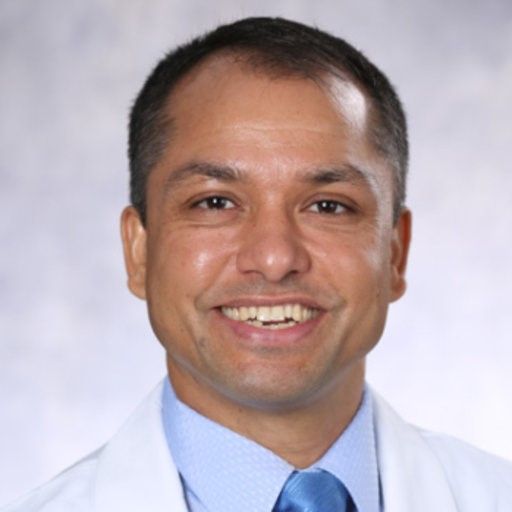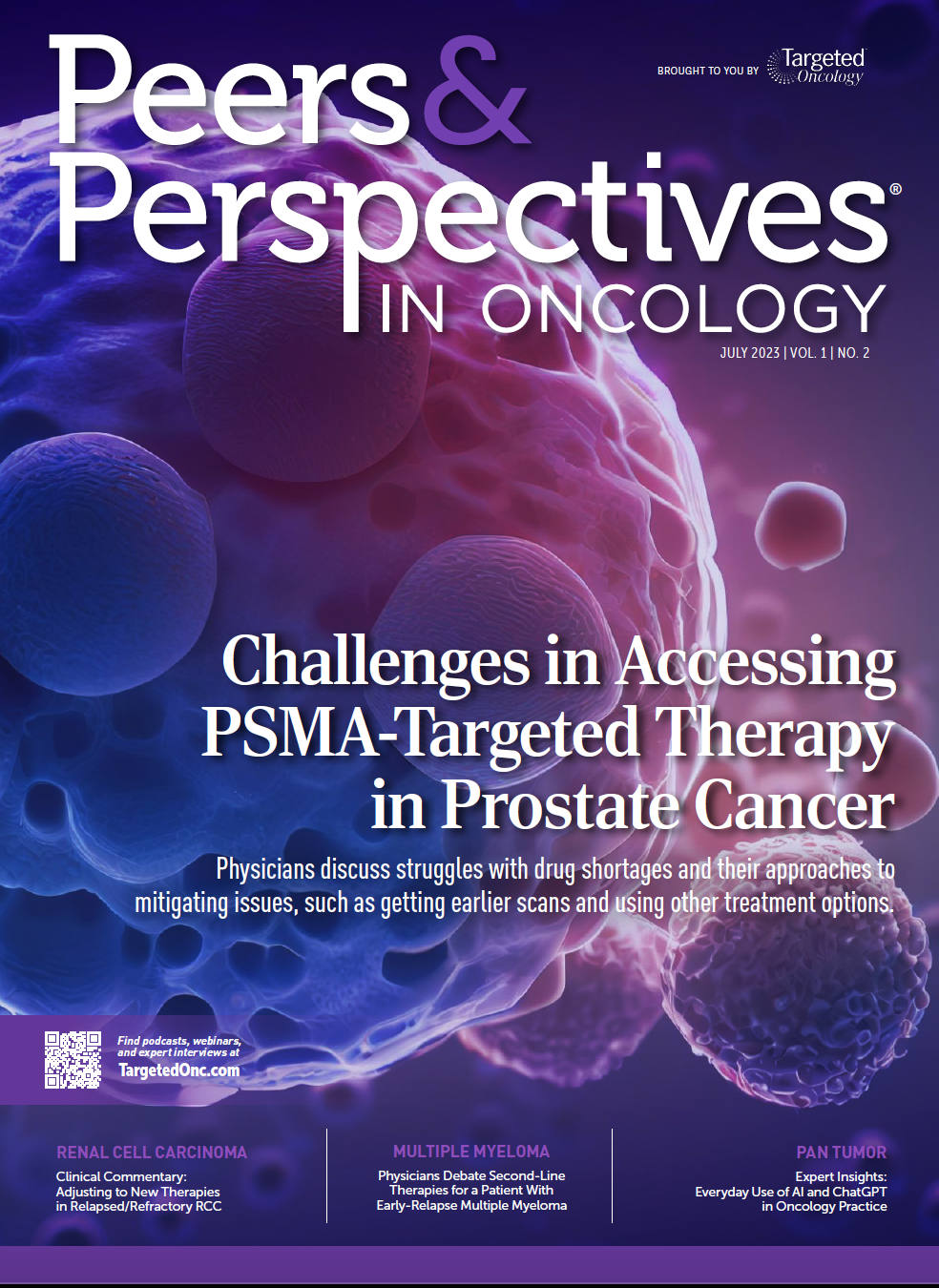PARTICIPANT LIST
Neil Nagovski, MD
Alex V. Mejia Garcia, MD
Jose Sandoval-Sus, MD
Judah Friedman, MD
Humberto. J. Caldera, MD
Matthew Salzberg, MD
Fernando de Zarraga, MD
Lowell L. Hart, MD
Harshad V. Amin, MD
Georges Azzi, MD
EVENT REGION: Florida
During a Targeted Oncology™ Case-Based Roundtable™ event, Chakra P. Chaulagain, MD, and participants discussed how they would treat a 54-year-old woman diagnosed with transplant-eligible R-ISS stage 2/R2-ISS stage 3 IgG-κ myeloma.
Chakra P. Chaulagain, MD
Director of Myeloma and Amyloidosis Program
Cleveland Clinic Florida
Weston, FL

Neil Nagovski, MD
Alex V. Mejia Garcia, MD
Jose Sandoval-Sus, MD
Judah Friedman, MD
Humberto. J. Caldera, MD
Matthew Salzberg, MD
Fernando de Zarraga, MD
Lowell L. Hart, MD
Harshad V. Amin, MD
Georges Azzi, MD
EVENT REGION: Florida
CASE SUMMARY
A 54-year-old woman presented with laboratory results including the following:
She had no cytogenetic (fluorescence in situ hybridization and karyotyping) abnormalities and had an ECOG performance status of 1. A PET and CT scan showed multiple bone lesions in her vertebrae without extramedullary disease. Her diagnosis was Revised International Staging System (R-ISS) stage 2/R2-ISS stage 3 IgG-κ myeloma, and she was identified as being eligible for autologous stem cell transplant (ASCT).

DISCUSSION QUESTIONS
NAGOVSKI: For the transplant-eligible patients, I’m trying to give a quadruplet regimen as much as I can, obviously insurance and financial limitations aside. So that has been my practice. I use Dara-VRd [daratumumab (Darzalex), bortezomib (Velcade), lenalidomide (Revlimid), and dexamethasone].
CHAULAGAIN: Have you encountered any insurance difficulties with approval?
NAGOVSKI: Not so much recently. One or [more] years ago I had a couple of pushbacks from insurance.
CHAULAGAIN: For patient tolerability, have you had good experiences?
NAGOVSKI: Yes. Daratumumab adds a little bit of toxicity but it’s not something that the patients cannot handle.
CHAULAGAIN: In the real-world setting, what has been your triplet vs quadruplet experience in terms of response rate?
MEJIA GARCIA: In general, I see very good results with both. If the patient has high-risk features or has issues with insurance, then I will not completely abandon triplet therapy. I’ve been leaning more toward 4 drugs, but I don’t measure MRD [minimal residual disease] routinely. The overall response rates [ORRs] are quite comparable so far.
CHAULAGAIN: Dr Sandoval, have you used any other quadruplet therapy for induction in transplant-eligible patients with NDMM outside of Dara-VRd?
SANDOVAL-SUS: No, I have not. Because of the strong phase 3 data for the triplet, I was reluctant to change. But nowadays, especially for patients with advanced disease who are young and eligible for transplant like in this case, I’m doing the quadruplet therapy. I also like it because it’s usually 4 cycles, then we go to transplant right away. It’s so powerful.
In the case that you presented, maybe one can start with VCd [bortezomib, cyclophosphamide, and dexamethasone) the first time around and then change to the quadruplet because creatinine clearance was a little bit decreased. But sometimes you can play around with the dose of lenalidomide as well.
CHAULAGAIN: I agree, because sometimes patients who may have started therapy in the hospital are often admitted with hypercalcemia, renal insufficiency, and significant anemia. I agree with doing something gentler and more renal protective. Also, getting daratumumab in the hospital may be cost prohibitive. Has anyone used quadruplet therapy that’s not Dara-VRd for induction in a [patient with] multiple myeloma who is transplant eligible?
FRIEDMAN: I use a quadruplet mainly for higher-risk patients, and like you mentioned with the renal problems, I’ll use daratumumab, cyclophosphamide, bortezomib, and dexamethasone [Dara-CyBorD]. I find lenalidomide difficult to dose in patients with fluctuating renal function.
CHAULAGAIN: Yes, a lot of us do use Dara-CyBorD, though there may not be a lot of evidence for upfront use. But especially in [patients with] renal insufficiency, we do use it.
CALDERA: If you look at the NCCN [National Comprehensive Cancer Network] guidelines, the preferred induction is VRd.1 I had this discussion with a payer last week, and their argument was that VRd is the preferred induction regimen by the NCCN. Not for every patient, but [with] some payers we have a hard time doing a quadruplet up front.
CASE UPDATE
Dara-VRd induction therapy was initiated, and the patient achieved a very good partial response (VGPR) post induction therapy. She underwent stem cell mobilization, and 2 months later underwent ASCT. Post ASCT, the response was still a VGPR.
DISCUSSION QUESTION
CHAULAGAIN: This patient had Dara-VRd for induction and went for transplant. The induction response was VGPR. Posttransplant response was still VGPR, so it didn’t move much. How should we treat this patient? How many of us believe in consolidation, and what type of consolidation? Dr Salzberg, would you offer this patient some consolidation therapy? What should be the consolidation therapy for this patient who did not have a major response after ASCT and who had a VGPR with quadruplet therapy prior to ASCT?
SALZBERG: I don’t see a ton of these patients. Recently, a lot of the patients I’m seeing are ones [who] are coming through a hospital from Florida. We’ve been able to get [consolidation] on a few patients, but others we’ve had trouble just trying to stabilize them. In years past, when I was treating these patients and giving VRd, I would send them for ASCT. Often they would come back and I would put them on some sort of maintenance therapy. These days, I’m not seeing them enough.
CHAULAGAIN: There is no controversy about maintenance therapy in multiple myeloma, but consolidation is still an evolving topic.
DE ZARRAGA: I wouldn’t [give consolidation]. I’m just wondering, for the physicians who do give consolidation in a patient who had a VGPR post transplant, what’s the goal? What are we trying to achieve with consolidation for a patient like this?
SANDOVAL: I usually don’t do consolidation. I try to give maximal treatment before the ASCT, meaning that I don’t usually do just 4 [drugs]. I go by the response. But, in general, I think about consolidation only in very high-risk patients. And it’s not really consolidation, it’s more like a maintenance with 2 medications for patients with high-risk cytogenetics and things like that. But I usually don’t do consolidation.
CHAULAGAIN: We talked a little bit about maintenance therapy. In the GRIFFIN trial [NCT02874742], they [received] 4 cycles of Dara-VRd followed by transplant, and then 2 additional cycles of consolidation.2 Would anyone consider 2 additional cycles of Dara-VRd for consolidation following the GRIFFIN trial [data], or will you go directly for maintenance therapy?
HART: I certainly would if the patient had low toxicity because it looks like they [received] all the benefit from [the] quadruplet up front and didn’t get much benefit from the transplant. I personally think in 10 years, transplants will go away completely as the other treatments keep getting better, just as they have in other scenarios.
I’m on the west coast of Florida. Most of my transplants are done at Moffitt [Cancer Center] up in Tampa, and patients usually come back on maintenance lenalidomide. But for this sort of patient, if their toxicity was low and they were doing great and were a younger patient, I would certainly consider giving a couple cycles of consolidation.
CHAULAGAIN: Dr Amin, would you go for 2 additional cycles of Dara-VRd or would you just go for lenalidomide or daratumumab plus lenalidomide maintenance?
AMIN: Like a colleague said earlier, we didn’t really achieve much with the transplant. The goal here is to maintain the VGPR at least. I would add a cycle of consolidation as a part of the protocol and then go on daratumumab plus lenalidomide maintenance. [I would] discuss the goal of treatment with the patient and inform them that sooner or later, changing the line of treatment will happen.
CHAULAGAIN: That makes sense because in the GRIFFIN study, the more daratumumab-based therapy you do, the better the response.3 A VGPR will convert to CR [complete response] and CR will convert to a stringent CR over time as long as you continue daratumumab-based therapy [From the Data3]. The MRD negativity also follows the same pattern. Let’s say we give this patient 2 cycles of Dara-VRd and the patient is now in CR, will you go ahead and follow the GRIFFIN trial and continue lenalidomide and daratumumab maintenance, or will you go on just single-agent lenalidomide maintenance?

AZZI: I would consider single-agent lenalidomide maintenance. I would probably use MRD data and see if the patient is MRD negative and maybe consider doing nothing in terms of the maintenance. If they’re [MRD] positive, though, I would probably continue with the dual agent.
CHAULAGAIN: Dr Caldera, do you [use] MRD in your practice and choose therapy based on the MRD results? Would you de-escalate therapy if the MRD was negative vs continue if the MRD was positive?
CALDERA: I don’t do that in my own practice, but in real life these patients go to a transplant center, and I usually coordinate the maintenance with them. I have not seen MRD being done routinely, at least at the University of Miami or Tampa where my patients go for transplant. I don’t personally do MRD in my practice. Most of my patients stay on lenalidomide for as long as they can tolerate it and they have good responses. So I usually monitor the M proteins and all the light chains every 3 months, and I keep them on lenalidomide. Some patients are going on daratumumab and lenalidomide now because these treatments are relatively new. I don’t have anyone [receiving] daratumumab maintenance longer than 1 year yet, but I have patients 7 years out still taking lenalidomide.
REFERENCES
1. NCCN. Clinical Practice Guidelines in Oncology. Multiple myeloma, version 3.2023. Accessed April 27, 2023. https://bit.ly/3oNV4n4
2. Voorhees PM, Kaufman JL, Laubach J, et al. Daratumumab, lenalidomide, bortezomib, and dexamethasone for transplant-eligible newly diagnosed multiple myeloma: the GRIFFIN trial. Blood. 2020;136(8):936-945. doi:10.1182/ blood.2020005288
3. Sborov DW, Laubach J, Kaufman JL, et al. Daratumumab (DARA) + lenalidomide, bortezomib, and dexamethasone (RVd) in patients with transplant-eligible newly diagnosed multiple myeloma (NDMM): final analysis of GRIFFIN. Abstract presented at: 19th International Myeloma Society Annual Meeting; August 25-27, 2022; Los Angeles, CA. Abstract OAB-057.

Survivorship Care Promotes Evidence-Based Approaches for Quality of Life and Beyond
March 21st 2025Frank J. Penedo, PhD, explains the challenges of survivorship care for patients with cancer and how he implements programs to support patients’ emotional, physical, and practical needs.
Read More